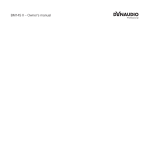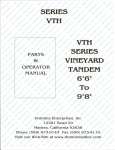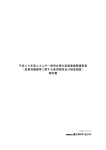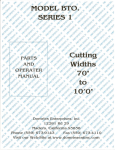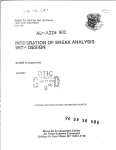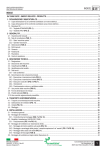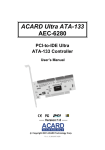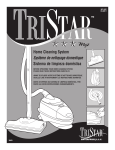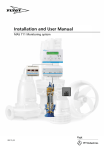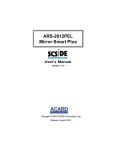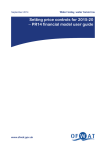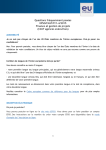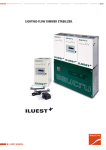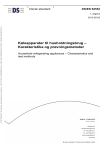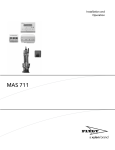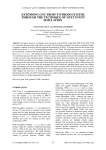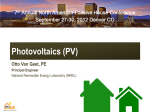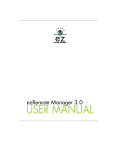Download D1.2 Document Inspection
Transcript
ECOPLIANT European Ecodesign Compliance Project Work Package 2: Overcoming Barriers and Establishing Best Practices Task 1: Identify and describe existing best practices for market surveillance and possible barriers to coordination Subtask 1.2: Document Inspection Requirements Final Report October 2014 Sonia Martín, FFII-LCOE with input from ECOPLIANT project partners Contents 1. INTRODUCTION .......................................................................................................................... 3 2. DESCRIPTION ............................................................................................................................. 3 3. DESK STUDIES ........................................................................................................................... 4 4. ANALYSIS OF SURVEY ............................................................................................................ 7 5. PRELIMINARY CONCLUSIONS AND WAY FORWARD .................................................. 11 6. PROTOCOLS ............................................................................................................................. 12 7. PRELIMINARY RECOMMENDATIONS ON BEST PRACTICE ........................................ 12 ANNEX: PROTOCOLS ..................................................................................................................... 13 The responsibility for the content and the recommendations of this subtask report lie with the author. They do not necessarily reflect the opinion of the ECOPLIANT project partners. However, the “Best practice” guidelines for coordinated and effective ecodesign market surveillance are the agreed views of the project partners. 2 1. INTRODUCTION The objective of ECOPLIANT - European Eco-design Compliance Project is to help deliver the intended economic and environmental benefits of the Ecodesign Directive 2009/125/EC by strengthening market surveillance and so increasing compliance with the provisions of the directive and the relevant implementing measures. 2. DESCRIPTION The aim of WP2 is to describe and establish a resource efficient and successful way of carrying out coordinated market surveillance activities across the EU. The main outcome of this work package will be: (i) drawing recommendations surveillance; for overcoming barriers to coordinated market (ii) the development and collection of the existing best practices that MSAs, with both limited and extensive experience and resources, are currently using when carrying out national market surveillance; (iii) the development of a set of guidelines to be used by MSAs for future coordinated and effective national market surveillance programme(s). The guidance developed in this WP will be validated and improved through the field work activities in WP3 (Pilot Action for EU Coordinated Monitoring, Verification and Enforcement) 2.1. Task 1: Identify and describe existing best practices for market surveillance and possible barriers to coordination This task is devoted to the review and analysis of a number of areas related to market surveillance: • requirements of the ecodesign directive and related product specific requirements, • national acts and enforcement systems • existing strategies and practices in different Member States. In each area, barriers for increased European coordination will be identified. In order to complement and confirm the data gathered throughout the studies, a comprehensive survey and a set of interviews is designed (in Task 2) to establish the situation in the partner countries. Subtasks 1.2 is under the responsibility of FFII-LCOE (Foundation for the Promotion of Industrial Innovation) 3 2.1.1. Subtask 1.2: Document Inspection Requirements The main goals of this subtask are: • Identify product documentation that manufacturers must submit for market surveillance Define the type of documents and information that manufacturers and importers must provide according to the requirements of Annex IV of 2009/125/EC Directive for each product and applicable regulation (product fiche, test reports, etc). Results of this analysis will feed into the relevant parameters and values identified in the action below. • Review and analysis of product documentation required by the Eco-Design Directive Carry out an analysis to determine the relevant product information that needs to be checked and included in product documentation, as required by the product specific regulations. This information includes the parameters or product features and calculations that must be included in the product fiches, declarations of conformity and other relevant product documents. Product parameters will need to be identified for different products, for example the model number, the type of product, the energy consumption, volume of the product, efficiency class, etc. This analysis will look at existing adopted product regulations to determine parameters that are requested for inclusion in product documentation for different products (e.g. TVs will have different relevant parameters to washing machines – for example, screen size rather than water consumption). • Identify information and technical parameters necessary for a product documentation database Analyse the Eco-Design Regulations to determine the relevant parameters (e.g. model, type, energy consumption, volume, efficiency class, etc) to be checked and included in an accessible and user friendly database. This information will feed into the information repository output of WP4. (This refers to a database for recording of market surveillance data, to be operated solely by market surveillance authorities.) 3. DESK STUDIES 3.1. Requirements of the Ecodesign directive (2009/125/EC). The points 2 and 3 of the Annex IV of the directive. state the following: 2. A technical documentation file making possible an assessment of the conformity of the product with the requirements of the applicable implementing measure must be compiled by the manufacturer. The documentation must contain, in particular: (a) general description of the product and of its intended use; (g) the results of measurements on the ecodesign requirements carried out, including details of the conformity of these measurements as compared with the ecodesign requirements set out in the applicable implementing measure. 3. The manufacturer must take all measures necessary to ensure that the product is manufactured in compliance with the design specifications referred to in point 2 and with the requirements of the measure which apply to it. 4 3.2. Product specific ecodesign requirements The Commission Regulation (EU) No 1015/2010 implementing Directive 2009/125/EC of the European Parliament with regard to ecodesign requirements for household washing machines in its Article 4 states the following: 2. For the purposes of conformity assessment pursuant to Article 8 of Directive 2009/125/EC, the technical documentation file shall contain a copy of the calculation set out in Annex II to this Regulation. Where the information included in the technical documentation for a particular household washing machine model has been obtained by calculation on the basis of design, or extrapolation from other equivalent washing machine, or both, the technical documentation shall include details of such calculations or extrapolations, or both, and of tests undertaken by manufacturers to verify the accuracy of the calculations undertaken. In such cases, the technical documentation shall also include a list of all other equivalent household washing machine models where the information included in the technical documentation was obtained on the same basis Similar articles are present in some other Regulations: 1016/2010 (dishwashers), 643/2009 (refrigerating appliances), etc. 3.3. Existing strategies and practices in different MS 3.3.1. Spain. IDAE database IDAE, the Spanish energy agency, has created a database with the most efficient appliances (refrigerating appliances, ovens, washing machines, dishwashers, etc). The participation in the database is voluntary for the manufacturers. They receive a protocol with the minimum content of the documentation that they shall provide Before introducing an appliance in the database, the complete technical file of the appliance must be sent to IDAE. If the result of a preliminary analysis of that documentation is positive, the appliance is introduced in the database. A further documental analysis is carried out in some randomly selected appliances in order to control the database. After a complete study of the documentation, if the appliance is found suspicious of non compliance, it will be tested. 3.3.2. Denmark. In 2011 and 2012 inspections of technical documentations and laboratory have been carried out for more than 500 products representing 12 different product categories (distributed on 374 inspection and 157 laboratory tests). The combination of inspections of technical documentation and laboratory testing has proven to be effective to enforce the ecodesign and energy labelling regulations. Furthermore it has made it possible to increase the number of products checked. Prior to the inspection of technical documentation a control sheet for the specific product category is elaborated (in an Excel-file). It is designed to include the information that shall be provided by the manufacturers according to the relevant regulation(s). The control sheet is an effective tool for the final evaluation of compliance. When evaluating the documentation provided by the manufacturer all the required data are to be identified by SEE (Secretariat for Ecodesign and Energy Labelling of Products) in the manufacturers’ technical documentation and filled into the control sheet. 5 Compliance is achieved when the control sheets show that the ecodesign minimum requirements are fulfilled and that the data declared on the energy label and in product fiche are substantiated by the technical documentation. If the documents from the manufacturers do not show that the ecodesign requirements are met or do not support the declared values, the product does not comply, and the manufacturer is asked to put things right. When a product does not comply, it shall either be withdrawn from the market or improved to meet the requirements. 3.4. ATLETE II The ATLETE II project (Appliance Testing for Washing Machines Energy Label & Ecodesign Evaluation project) is co-finaced by the IEE programme. The goals of the ATLETE II project are to check the pan-EU compliance of washing machines with energy labeling and eco-design requirements using the new measurement method, to improve the capacity of testing laboratories and at the same time support co-operation among national Authorities for effective market surveillance. The testing laboratories are asked to check the energy labeling and ecodesign requirements in the booklet of instructions and the product fiche of every tested model. 3.5. Conclusions Identified problems The documentation does not cover the ecodesign requirements of all the units covered under the same model identification. (e.g. For products with alternative components, the documentation does not cover all the construtions) Test reports show values that do not correspond to the rated values and no justification for these values can be found in the documentation Not all of the values requested for the determination of the indexes and rated values in labels are covered in the test reports The manufacturer / importer must guarantee the conformity of all the production but there is no information on how all the products from the production could meet the rated values of the applicable measures. (For example, this can be done using statistical evaluations of measurements of some parameters of the production) Conclusions The minimum content of the documentation and the rated and measured values to be provided need to be defined. The technical documentation must include a list with all the appliances covered by the same technical file (identity declaration) It is necessary to define in which way a manufacturer / importer must prove how all his production could meet the rated values of the applicable measures It is necessary to establish in what conditions the use of some tolerances between the rated values and those values measured by the manufacturer is acceptable. 6 These tolerances (production tolerances) are not those defined in the Regulations for the market surveillance. Example: A manufacturer/importer provides a test report and in a statistical evaluation of his production observes that the value of a parameter varies in ±x%. How could the manufacturer use this production tolerance in the rated value? 4. ANALYSIS OF SURVEY Within the ECOPLIANT project a survey is foreseen in order to get an overview of the market surveillance practices across Europe. Question 5 deals with technical document inspection. Products that are regulated under the Ecodesign directive 2009/125/EC need to have a file of technical documentation, for instance documents relating to the conformity assessment that have been carried out by the manufacturer. 5. Has your organisation been working with technical documentation inspection as a method for market surveillance of the Ecodesign directive? 20 MSAs answered the survey and 13 of them (65%) state that they have been working with technical documentation inspection as a method for market surveillance of the Ecodesign directive. If yes, a) For which products? (several answers possible) Air conditioners and comfort fans (EU) No 206/2012 Circulators (EC) No 641/2009 as amended by (EU) No 622/2012 Electric motors (EC) No 640/2009 Equipment (EC) No 1275/2008 External Power Supplies (EC) No 278/2009 Household dishwashers (EU) No 1016/2010 Household washing machines (EU) No 1015/2010 Industrial fans (EU) N°327/2011 Lighting Products in the Domestic Sector (EC) No 244/2009 as amended by (EC) No 859/2009 Lighting Products in the Tertiary Sectors (EC) No 245/2009 as amended by (EU) No 347/2010, 7 Refrigerators and freezers (EC) No 643/2009 Simple Set-Top Boxes (EC) No 107/2009 Standby and off Mode Electric Power Consumption of Household and Office (EC) 1725/2008 Televisions (EC) No 642/2009 Water pumps (EU) No 547/2012 Other_________________ No information available There are two different groups, those that have been working with more than 4 regulations and those that have been working with 4 regulations or less (approximately 46%). In this last group, some of the MSAs only have worked with one regulation. This situation must be taken into account to analyse their answers. The higher percentages correspond to products within: Standby and off Mode Electric Power Consumption of Household and Office Equipment (EC) No 1275/2008, Televisions (EC) No 642/2009, Refrigerators and freezers (EC) No 643/2009, Lighting Products in the Domestic Sector (EC) No 244/2009 as amended by (EC) No 859/2009 and External Power Supplies (EC) No 278/2009. (see figure 1) Figure 1. 8 b) Please mark the type of documentation requested by your organisation in market surveillance (several answers possible): EU-declaration of conformity List of products covered by the same technical file (identity declaration) Test report Energy label (if applicable) User manual Technical fiche Calculations required by the Ecodesign directive Measures taken during the production process to guarantee that all the products comply with the relevant ecodesign requirements. Other__________________________ No information available When it comes to the type of documentation requested by each organisation in market surveillance, all the respondents indicate the option EU declaration of conformity. Other types of documentation requested to a significant extent include: Test report (92%), Technical fiche (77%) and Energy label (69%). The option “measures taken during the production process” stands out for its low percentage. Since most of the Ecodesign regulations include requirements about the user manual, it is difficult to understand that only the 54% of the respondents request this type of documentation. c) If after the request, analysis and when necessary, the confrontation with the manufacturer, the conclusion is that product documentation cannot demonstrate its conformity with the relevant requirements of the Ecodesign directive (or similar product directives), what do you do, as a MSA? We consider that the product does not comply with the Ecodesign directive We use this situation to select the product for testing. Other Comments___________________________ 9 If the product documentation cannot demonstrate its conformity with the relevant requirements of the Ecodesign directive (or similar product directives) the 60% of the respondents state that they would consider that the product does not to comply with the Ecodesign directive and the 30% would use the situation to select the product for testing It is important to point out that the majority of the MSAs that have been working with technical document inspection consider it as a proof that a product does not comply with the Ecodesign Directive. If there is no need to perform tests or the number of tests is reduced, this would be an important saving. d) If the technical documentation of a product does not comply with the provisions of the Ecodesign directive (or applicable regulation), but when this product is tested, it then complies with this directive; does your organisation consider then that the product still does not comply with the applicable regulation? Answers: Yes / No / It depends on the situation / No information available Comments:___________________ In this question we have two kinds of answers: a) Those who consider that the product does not comply with the directive but the measures to be taken have to be proportional and they must be softer than in the case of “physical non-compliance”. A MSA, for example, makes a difference between fines and bans: “The documentation still does not comply but the product would not be banned. The manufacturer/importer would be ordered to provide correct documentation. If not, there would be fines. These would be more severe if consumer information is affected than for information in the technical file. Blatantly wrong consumer information can lead to a ban of the product, even if it complies with limit values in the physical test. For many important products a fine is more significant because they are only sold for a short time and have been sold out by retailers before the ban takes effect. Distinction between formal and physical non-compliance makes a difference for fines and for proportionality principle when considering a ban.” b) Those who consider that the compliance of a product is only related to the results of the tests. These are some of the comments of the MSAs: “We don't care much about the paperwork, because paper and words are cheap. What matters is the compliance of the product in tests. Ideally, it would be great if papers are correct but that is the case only with bigger, well-known manufacturers usually of European origin” “Compliance with the directive as a result from measurements, is the most important; we will request the manufacturer/importer to improve the documents 10 e) Please note if you have any recommendations or results concerning technical documentation inspection that you would like to share with the Ecopliant project: ___________________ These are the recommendations of the MSAs: 1) You have to look close at the specific regulation and note (record) all the critical parameters. 2) I think we market surveillance authorities have to be realistic, it is very rare to encounter a product that complies with everything that CE-marking requires. Even if the product passes LVD, EMC, EcoDesign, Labelling, and RoHS tests, there usually is something in declaration of conformity or other paperwork. If we were to ban products based on inconsistence in paperwork, the market shelves would be quite empty, at least in so-called low-cost shops. 3) Important to realize that -document inspection is not always easy and you need some experience to do it in a properly way- it would be good to come to more standardization of the documents to be filled in by the manufacturer; now there is a lot difference in documents from the different manufacturers which makes it difficult for us to check them and also for the manufacturers it would be easier to use standard forms- documentation comes from manufacturer himself for whom it is important to show compliance-also documentation that looks perfect, can include information which is not true-document inspection is a first and only one picture we get from the method of a manufacturer; an inspection and information about his knowledge and his involvement with Ecodesign, can complete the picture- The only way to know for sure whether the product meets the requirements, is doing a measurement! 4) In some ECODESIGN regulations it is requested an statistical analysis ( test on three additional samples) when only one sample is found not in accordance with the requested ecodesign values. When the technical documentation ( mainly the test report and calculations) is or it is clearly wrong, we consider that there is no reason to repeat test, because no discrepancy have to be clarified 5. PRELIMINARY CONCLUSIONS AND WAY FORWARD It have been developed some protocols regarding some selected Regulations. For each type of appliance, it has been defined: • Minimum content of the requested documentation • Minimum required technical parameters These protocols will be evaluated during the document inspection exercise of WP3 (Pilot Action for EU Coordinated Monitoring, Verification and Enforcement) 11 6. PROTOCOLS We have carried out an analysis to determine the relevant product information that needs to be checked and included in product documentation as required by the product specific regulations. A protocol for each one of some selected regulations has been developed. (See Annex) The different regulations have been analyzed in order to know: the generic and specific ecodesign requirements for each type of appliance. the technical parameters needed to calculate the required indexes the required documentation and those other documentation that contains technical parameters that are needed to make the evaluation All these information has been reflected in the protocols. A protocol with general instructions for the document inspection exercise of WP3 has been developed, too. 7. PRELIMINARY RECOMMENDATIONS ON BEST PRACTICE Document inspection is an important part of market surveillance. Document inspection is a stand-alone activity: if the documentation of a product does not meet the requirements of its corresponding Ecodesign regulation, the product does not comply with the Ecodesign Directive. It is very important to point out that documental inspection means significant costs saving in market surveillance. It is also very useful to select products for testing. It is essential to define the same rules for document inspection in all the MS. If there are different rules, it would be confusion. (The same manufacturer/importer could send the same documentation to different countries and it could be accepted only in some of them) After analysing the survey answers, it seems that some MSAs do not consider the document inspection as important as the tests. Bearing in mind the requirements of the Directive and the different Regulations, we recommend some training to clarify the importance of document inspection. 12 ANNEX: PROTOCOLS 13 PROTOCOL FOR DOCUMENT INSPECTION APPLIANCE: WASHING MACHINE Document content: 1. Introduction 2. Minimum content of the documentation 3. Register of the appliance in the document inspection file of Ecopliant project 4. Cálculation of the ecodesign requirements 5. Example 6. Generic ecodesign requirements compliance 7. Annex II of REGULATION (EU) No 1015/2010 14 1.-INTRODUCTION The present protocol will be used for documental inspection for washing machines according the COMMISSION REGULATION (EU) No 1015/2010 of 10 November 2010 implementing Directive 2009/125/EC of the European Parliament and of the Council with regard to ecodesign requirements for household washing machines This regulation applies from 1 December 2011. However, the ecodesign requirements listed below shall apply in those appliances placed in the market after these dates, in accordance with the following timetable: (a) the generic ecodesign December 2012; (b) the generic ecodesign June 2011; (c) the generic ecodesign December 2013; (d) the specific ecodesign December 2013. requirements set out in point 1(1) of Annex I shall apply from 1 requirements set out in point 1(2) of Annex I shall apply from 1 requirements set out in point 1(3) of Annex I shall apply from 1 requirements set out in point 2(2) of Annex I shall apply from 1 This Regulation establishes ecodesign requirements for the placing on the market of electric mains-operated household washing machines and electric mains-operated household washing machines that can also be powered by batteries, including those sold for nonhousehold use and built-in household washing machines. This Regulation shall not apply to household combined washer-driers. 2.- MINIMUM CONTENT OF THE DOCUMENTATION The manufacturer, or the representative office in each country as intermediate, could be requested to send to the Member State Authorities responsible for documental inspection according the regulation 1015/2010 the following documentation: o Identity declaration. List of products with its model identification sold in any Member State that are covered by the same technical file according to Annex IV (point 2.a) of Directive 2009/125/EC. For the surveillance purposes the technical file is identified by the trademark and the model of the product which is referred on it (model(s) really tested in the test report and/or particularly considered in the calculations) and it is defined as “basis model”. It is assumed that all product covered by the same technical documentation shall have the same nominal values (in the label, or in the technical fiche, when relevant). The identity declaration can be a part of the technical file or a different document o Energy label o Test report containing the measured values used for the determination of the rated according Annex I of regulation 1061/2010. All trademarks and models with the same basis model shall have the same values in the label. values, according to Annex IV (point 2.g) of Directive 2009/125/EC. In the absence of any other calculations or documents, the trademarks and models really tested on it are considered basis models 15 o Calculations, if they are not included in the test report. These calculations must comply with the point 2 of article 4 of the regulation 1015/2010 that states: ”Where the information included in the technical documentation for a particular household washing machine model has been obtained by calculation on the basis of design, or extrapolation from other equivalent washing machines, or both, the technical documentation shall include details of such calculations or extrapolations, or both, and of tests undertaken by manufacturers to verify the accuracy of the calculations undertaken” . When calculations give the possibility to change the nominal values of certain models using the same test report, these models became new basis models in the sense of this exercise. In these cases the calculations to justify the new values should be evaluated and accepted previously. o Technical fiche according Annex II of regulation 1061/2010. All trademarks and models with the same basis model shall have the same values in the technical fiche. o Declaration of Conformity of the manufacturer or his authorised representative established within the Community, indicating that the product is according the requirements of Directive 2009/125/EC o Booklet of instructions. The following technical values must be found in this documentation: MINIMUM REQUIRED TECHNICAL PARAMETERS VALUES FOR THE CALCULATIONS OF THE DOCUMENT INSPECTION EXERCISE. To be found in the test reports, in the documental calculations, or in both: - Annual energy consumption; AEc (kWh) Remaining moisture content; D (%) Annual water consumption; AWc (l) Washing efficiency index; Iw Energy efficiency index; EEI Energy consumption of the standard 60ºC cotton programme, Et,60 Energy consumption of the standard 60ºC cotton programme at partial load, Et,60,1/2 Energy consumption of the standard 40ºC cotton programme at partial load, Et,40,1/2 Power in “off-mode” of the standard 60ºC cotton programme at full load, Po,60, Power in “off-mode” of the standard 60ºC cotton programme at partial load, Po,60,1/2 Power in “off-mode” of the standard 40ºC cotton programme at partial load, Po,401/2 Power in “left-on mode” of the standard 60ºC cotton programme at full load, Pl,60 (*) Power in “left-on mode” of the standard 60ºC cotton programme at partial load, Pl,60,1/2 (*) Power in “left-on mode” of the standard 40ºC cotton programme at partial load, Pl,40,1/2 (*) Programme time of the standard 60ºC cotton programme at full load, Tt,60 Programme time of the standard 60ºC cotton programme at partial load, Tt,60,1/2 Programme time of the standard 40ºC cotton programme at partial load, Tt,40,1/2 Time in “left-on mode” of the standard 60ºC cotton programme at full load, Tl,60 (*) Time in “left-on mode” of the standard 60ºC cotton programme at partial load, Tl,60,1/2 (*) Time in “left-on mode” of the standard 40ºC cotton programme at partial load, Tl,40,1/2 (*) 16 - Water consumption; Wt (l) (water consumption of the standard 60 °C cotton programme at full load) (*) In the standard EN60456:11 the “left-on mode” is divided in two phases: LU (unstable left on mode) and LO (stable left on mode). We will take the values corresponding to phase LO. 17 3.-REGISTER OF THE APPLIANCES IN THE DOCUMENT INSPECTION FILE OF ECOPLIANT PROJECT Firstly, the product identification data according the Identity Declaration are introduced in the web. Appliance Number of file Basis appliance trade mark Basis appliance model Trade mark Model 4.- CALCULATION OF THE ECODESIGN REQUIREMENTS After introducing the identification data, the following tables must be filled out with the technical parameters values: Rated capacity (kg) Power management system Yes/No Energy consumption (kWh) Power in “off-mode (W) Power in “left-on mode (W) Programme time (min) Time in “left-on mode” (min) Standard 60oC cotton programme at full load Standard 60oC cotton programme at partial load Standard 40oC cotton programme at partial load Et,60= Po,60= Pl,60= Tt,60= Tl,60= Et,60,1/2= Po,60,1/2= Pl,60,1/2= Tt,60,1/2= Tl,60,1/2= Et,40,1/2= Po,40,1/2= Pl,40,1/2= Tt,40,1/2= Tl,40,1/2= (If the above data cannot be found in the test report, the measured annual energy consumption value can be filled out in the following table) CONCEPT Rated value Declared Class Measured value Request Deviation (1015/2010) (1061/2010) Annual energy consumption AEc (kWh) Remaining moisture content D Annual water consumption AWc (l) Washing efficiency index Iw Energy efficiency index EEI Water consumption Wt (l) >1,03 <68 18 The data provided by the manufacturer are introduced in the white cells. Blue cells will be filled out with the result of some calculations. For additional information see annex II of REGULATION (EU) No 1015/2010 5.- GENERIC ECODESIGN REQUIREMENTS COMPLIANCE The following table will be filled out with the content of the documentation Requirement Mandatory date “Standard 60ºC cotton programme” and “Standard 40ºC cotton programme” clearly identified on the programme selection device or the display of the appliance The booklet of instructions provides: - The standard 60ºC cotton programme - The standard 40ºC cotton programme - indication that they are the most efficient programmes in terms of combined energy and water consumptions for washing normally soiled cotton laundry - indication that the actual water temperature may differ from the declared cycle temperature - power consumption of the offmode -power consumption of the left-on mode - indicative information on the programme time, remaining moisture content, energy and water consumption for the main washing programmes at full or partial load, or both - recommendation on the type of detergents suitable for the various washing temperatures Presence of a 20°C washing cycle This programme is clearly identified on the programme selection device or the display of the appliance 1 December 2012 Yes No Not applicable Not checked 1 June 2012 1 June 2012 1 June 2012 1 June 2012 1 June 2012 1 June 2012 1 June 2012 1 June 2012 1 June 2012 1 December 2013 1 December 2013 19 6.- EXAMPLE We introduce the identification data: Appliance Number of file Basis appliance trade mark Basis appliance model Trade mark Model Washing machine 20120925 BB&W GEN20011BB BLUE BL10F222FF We fill out the following cells with data from the test report Rated capacity (kg) Power management system 8 No Energy consumption (KWh) Power in “off-mode (W) Power in “left-on mode (W) Programme time (min) Time in “left-on mode” (min) Standard 60oC cotton programme at full load Et,60= 1,079 Po,60= 0,34 Pl,60= 0,75 Tt,60= 240 Tl,60= 40 Standard 60oC cotton programme at partial load Et,60,1/2= 0,795 Po,60,1/2= 0,34 Pl,60,1/2= 0,68 Tt,60,1/2= 210 Tl,60,1/2= 40 Standard 40oC cotton programme at partial load Et,40,1/2= 0,636 Po,40,1/2= 0,34 Pl,40,1/2= 0,74 Tt,40,1/2= 209 Tl,40,1/2= 40 Then, we introduce the data of the energy label in the column “Rated value” and the data of the test report en the column “Measured value” CONCEPT Annual energy consumption AEc (kWh) Remaining moisture content D Annual water consumption AWc (l) Washing efficiency index Iw Energy efficiency index EEI Water consumption Wt (l) Rated value Declared Class Measured value C 53 Request Deviation (1015/2010) (1061/2010) 218 9600 10590 1,045 >1,03 <68 A++ 48 We would obtain the following results: 20 CONCEPT Annual energy consumption AEc (kWh) Remaining moisture content D Annual water consumption AWc (l) Washing efficiency index Iw Energy efficiency index EEI Water consumption Wt (l) Rated value Declared Class 218 <63 C 11000 <52 A++ Measured value Request Deviation (1015/2010) (1061/2010) 195,87 -9,69% 53 -15,87% 11850 7,73% 1,045 >1,03 45,8 <68 56 <75 -11,92% 21 7.- ANNEX I OF REGULATION (EU) No 1015/2010 22 PROTOCOL FOR DOCUMENT INSPECTION APPLIANCE: REFRIGERATING APPLIANCES Document content: 1. Introduction 2. Minimum content of the documentation 3. Register of the appliance in the document inspection file of Ecopliant project 4. Cálculation of the ecodesign requirements 5. Generic ecodesign requirements compliance 6. Example 7. Annex II of REGULATION (EU) No 643/2009 23 1.-INTRODUCTION The present protocol will be used for documental inspection for refrigerating appliances according the COMMISSION REGULATION (EU) No 643/2009 of 22 July 2009 implementing Directive 2009/125/EC of the European Parliament and of the Council with regard to ecodesign requirements for household refrigerating appliances This regulation applies from 1 July 2010. However, the ecodesign requirements listed below shall apply in those appliances placed in the market after these dates, in accordance with the following timetable: - The generic July 2010. - The generic July 2013. - The specific Annex II shall ecodesign requirements set out in point 1(1) of Annex II shall apply from 1 ecodesign requirements set out in point 1(2) of Annex II shall apply from 1 ecodesign requirements for the Energy Efficiency Index set out in point 2 of apply in accordance with the timetable set out in Tables 1 and 2 of Annex II. This Regulation establishes ecodesign requirements for the placing on the market of electric mains-operated household refrigerating appliances with a storage volume up to 1 500 litres. This Regulation shall apply to electric mains-operated household refrigerating appliances, including those sold for non-household use or for the refrigeration of items other than foodstuffs. It shall also apply to electric mains-operated household refrigerating appliances that can be battery-operated. This Regulation shall not apply to: (a) refrigerating appliances that are primarily powered by energy sources other than electricity, (b) battery-operated refrigerating appliances that can be connected to the mains through an AC/DC converter, purchased separately; (c) custom-made refrigerating appliances, made on a one-off basis and not equivalent to other refrigerating appliance models; (d) refrigerating appliances for tertiary sector application where the removal of refrigerated foodstuffs is electronically sensed and that information can be automatically transmitted through a network connection to a remote control system for accounting; (e) appliances where the primary function is not the storage of foodstuffs through refrigeration, such as stand-alone ice-makers or chilled drinks dispensers 24 2.- MINIMUM CONTENT OF THE DOCUMENTATION The manufacturer, or the representative office in each country as intermediate, could be requested to send to the Member State Authorities responsible for documental inspection according the regulation 643/2009 the following documentation: o Identity declaration. List of products with its model identification sold in any Member State that are covered by the same technical file according to Annex IV (point 2.a) of Directive 2009/125/EC. For the surveillance purposes the technical file is identified by the trademark and the model of the product which is referred on it (model(s) really tested in the test report and/or particularly considered in the calculations) and it is defined as “basis model”. It is assumed that all product covered by the same technical documentation shall have the same nominal values (in the label, or in the technical fiche, when relevant). The identity declaration can be a part of the technical file or a different document o Energy label o Test report containing the measured values used for the determination of the rated according Annex II of regulation 1060/2010. All trademarks and models with the same basis model shall have the same values in the label. values, according to Annex IV (point 2.g) of Directive 2009/125/EC. In the absence of any other calculations or documents, the trademarks and models really tested on it are considered basis models o Calculations, if they are not included in the test report. Where the information included in the technical documentation for a particular refrigerating appliance model has been obtained by calculation on the basis of design, or extrapolation from other equivalent refrigerating appliances, or both, the technical documentation shall include details of such calculations or extrapolations, or both, and of tests undertaken by manufacturers to verify the accuracy of the calculations undertaken. When calculations give the possibility to change the nominal values of certain models using the same test report, these models became new basis models in the sense of this exercise. In these cases the calculations to justify the new values should be evaluated and accepted previously. o Technical fiche according Annex III of regulation 1060/2010. All trademarks and models with the same basis model shall have the same values in the technical fiche. o Declaration of Conformity of the manufacturer or his authorised representative established within the Community, indicating that the product is according the requirements of Directive 2009/125/EC o Booklet of instructions. The following technical values must be found in this documentation: 25 MINIMUM REQUIRED TECHNICAL PARAMETERS VALUES FOR THE FOR THE CALCULATIONS OF THE DOCUMENT INSPECTION EXERCISE. To be found in the test reports, in the documental calculations, or in both: - Annual energy consumption; AEc (kWh) Volume of fresh food storage compartments (l) Volume of frozen food storage compartments (l) Energy efficiency index; EEI Measured energy consumption (kWh/24h), E24h Appliance category (from 1 to 10) according to table 1 of annex IV of regulation 643/2009, see point 7 of this protocol. Measured storage volume of every compartment; (refrigerator, freezer, one starsection, two-star section, chill compartment) Vc (l) Frost free compartments Climatic class according to table 3 of annex IV of regulation 643/2009 (SN, N; ST or T) 26 3.-REGISTER OF THE APPLIANCES IN THE DOCUMENT INSPECTION FILE OF ECOPLIANT PROJECT Firstly, the product identification data according the Identity Declaration are introduced in the web. Appliance Number of file Basis appliance trade mark Basis appliance model Trade mark Model 4.- CALCULATION OF THE ECODESIGN REQUIREMENTS After introducing the identification data, the following tables must be filled out with the technical parameters values: Chill compartment (storage volume Yes/No ≥15 l) Built in appliance Yes/No Climatic class Appliance category Measured Energy consumption E24h (kWh/24h) Compartment Refrigerator Chill compartment Freezer *** Two-star sections** One-star sections* Measured Vc (l) Tc (ºC) +5 0 -18 -12 -6 FF (Frost free) Yes/No Yes/No Yes/No Yes/No Yes/No If one of these compartments is not present in the appliance, the corresponding cells must be left blank. CONCEPT Rated value Declared Class Measured value Request (643/2009) Deviation (1060/2010) Annual energy consumption AEc (kWh) Volume of fresh food storage compartments (l) Volume of frozen food storage compartments (l) 27 Energy efficiency index EEI <55 The data provided by the manufacturer are introduced in the white cells. Blue cells will be filled out with the result of some calculations. Brown cells are fixed values. For additional information see annex III of REGULATION (EU) No 643/2009 28 5.- GENERIC ECODESIGN REQUIREMENTS COMPLIANCE The following table will be filled out with the content of the documentation Requirement Mandatory date For wine storage appliances, the following information is displayed in the instruction booklet: ‘This 1 July 2010 For household refrigerating appliances, the booklet of instructions provides: - the combination of drawers, baskets and shelves that result in the most efficient use of energy for the appliance - how to minimise the energy consumption of the household refrigerating appliance in the usephase The fast freezing facility, or any similar function achieved through modification of the thermostat settings, in freezers and freezer compartments, once activated by the end-user according to the manufacturer’s instructions, automatically reverts to the previous normal storage temperature conditions after no more than 72 hours. (This requirement does not apply to refrigerator-freezers with one thermostat and one compressor which are equipped with an electromechanical control board.) Refrigerator-freezers with one thermostat and one compressor which are equipped with an electronic control board and can be used in ambient temperatures below + 16 °C according to the manufacturer’s instructions are such that any winter setting switch or similar function guaranteeing the correct frozen-food storage temperature is automatically operated according to the ambient temperature where the appliance is installed. Household refrigerating appliances with a storage volume below 10 litres automatically enters in an operating condition with a power consumption of 0,00 W after no 1 July 2010 Yes No Not applicable Not checked appliance is intended to be used exclusively for the storage of wine’. 1 July 2010 1 July 2010 1 July 2013 1 July 2013 1 July 2013 29 more than 1 hour when empty. 6.- EXAMPLE We introduce the identification data: Appliance Number of file Basis appliance trade mark Basis appliance model Trade mark Model Refrigerating appliance 20121207 BB&A SB20 BB&A SC40 We fill out the following cells with data from the test report. Chill compartment (storage volume ≥15 l) Built in appliance Climatic class Appliance category Measured Energy consumption E24h (kWh/24h) Compartment Refrigerator Chill compartment Freezer *** Two-star sections** One-star sections* Yes No T 6 0,475 Measured Vc (l) 185,28 32,34 66,2 ----- Tc (ºC) 5 0 -18 -12 -6 FF No No Yes ----- Then, we introduce the data of the energy label in the column “Rated value” and the data of the test report en the column “Measured value” CONCEPT Annual energy consumption AEc (kWh) Volume of fresh food storage compartments (l) Rated value Declared Class Measured value Request (643/2009) Deviation (1060/2010) 159 219 30 Volume of frozen food storage compartments (l) Energy efficiency index EEI 66 A+++ <55 We would obtain the following results: CONCEPT Annual energy consumption AEc (kWh) Volume of fresh food storage compartments (l) Volume of frozen food storage compartments (l) Energy efficiency index EEI Rated value Declared Class Measured value Request (643/2009) Deviation (1060/2010) 159 173,37 9,04% 219 218 -0,46% 66 66 0% <22 A+++ 24 <55 9,09% 31 7.- ANNEX II OF REGULATION (EU) No 643/2009 32 8.- ANNEX II OF REGULATION (EU) No 643/2009 33 PROTOCOL FOR DOCUMENT INSPECTION APPLIANCE:DISHWASHER Document content: 1. Introduction 2. Minimum content of the documentation 3. Register of the appliance in the document inspection file of Ecopliant project 4. Cálculation of the ecodesign requirements 5. Generic ecodesign requirements complianc 6. Example 7. Annex II of REGULATION (EU) No 1016/2010 34 1.-INTRODUCTION The present protocol will be used for documental inspection for washing machines according the COMMISSION REGULATION (EU) No 1016/2010 of 10 November 2010 implementing Directive 2009/125/EC of the European Parliament and of the Council with regard to ecodesign requirements for household dishwashers This regulation applies from 1 December 2011. However, the ecodesign requirements listed below shall apply in accordance with the following timetable: (a) the generic ecodesign requirements set out in point 1(1) of Annex I shall apply from 1 December 2012; (b) the generic ecodesign requirements set out in point 1(2) of Annex I shall apply from 1 June 2011; (c) the generic ecodesign requirements set out in point 2(2) of Annex I shall apply from 1 December 2013; (d) the specific ecodesign requirements set out in point 2(3) of Annex I shall apply from 1 December 2016. This Regulation establishes ecodesign requirements for the placing on the market of electric mains-operated household dishwashers and electric mains-operated household dishwashers that can also be powered by batteries, including those sold for non-household use and builtin household dishwashers 2.- MINIMUM CONTENT OF THE DOCUMENTATION The Member State Authorities responsible for documental inspection according the regulation 1016/2010 shall have at their disposal at least the following documentation: o Identity declaration. List of products with its model identification sold in any Member State that are covered by the same technical file according to Annex IV (point 2.a) of Directive 2009/125/EC. For the surveillance purposes the technical file is identified by the trademark and the model of the product which is referred on it (model(s) really tested in the test report and/or particularly considered in the calculations) and it is defined as “basis model”. It is assumed that all product covered by the same technical documentation shall have the same nominal values (in the label, or in the technical fiche, when relevant). The identity declaration can be a part of the technical file or a different document o Energy label o Test report containing the measured values used for the determination of the rated according Annex I of regulation 1059/2010. All trademarks and models with the same basis model shall have the same values in the label. values, according to Annex IV (point 2.g) of Directive 2009/125/EC. In the absence of any other calculations or documents, the trademarks and models really tested on it are considered basis models o Calculations, if they are not included in the test report. Where the information included in the technical documentation for a particular household dishwasher model 35 has been obtained by calculation on the basis of design, or extrapolation from other equivalent dishwashers, or both, the technical documentation shall include details of such calculations or extrapolations, or both, and of tests undertaken by manufacturers to verify the accuracy of the calculations undertaken. When calculations give the possibility to change the nominal values of certain models using the same test report, these models became new basis models in the sense of this exercise. In these cases the calculations to justify the new values should be evaluated and accepted previously. o Technical fiche according Annex II of regulation 1059/2010. All trademarks and models with the same basis model shall have the same values in the technical fiche. o Declaration of Conformity of the manufacturer or his authorised representative established within the Community, indicating that the product is according the requirements of Directive 2009/125/EC o Booklet of instructions The following technical values must be found in this documentation: MINIMUM REQUIRED TECHNICAL PARAMETERS VALUES FOR THE CALCULATIONS OF THE DOCUMENT INSPECTION EXERCISE. To be found in the test reports, in the documental calculations, or in both: - Annual energy consumption; AEc (kWh) Annual water consumption; AWc (l) Drying efficiency index; ID Washing efficiency index; IC Energy efficiency index; EEI Energy consumption of the standard cycle, Et (kWh) Power in “off-mode” for the standard cleaning cycle, Po (W) Power in “left-on mode” for the standard cleaning cycle, Pl (W) Programme time for the standard cleaning cycle, Tt (min) Time in “left-on mode” for the standard cleaning cycle, Tl (min) 36 3.-REGISTER OF THE APPLIANCES IN THE DOCUMENT INSPECTION FILE OF ECOPLIANT PROJECT Firstly, the product identification data according the Identity Declaration are introduced in the web. Appliance Number of file Basis appliance trade mark Basis appliance model Trade mark Model 4.- CALCULATION OF THE ECODESIGN REQUIREMENTS After introducing the identification data, the following tables must filled out with the technical parameters values: Number of place of settings Width (cm) Power management system Yes/No Energy consumption of the standard cycle, Et (kWh) Power in “off-mode” for the standard cleaning cycle, Po (W) Power in “left-on mode” for the standard cleaning cycle, Pl (W) Programme time for the standard cleaning cycle, Tt (min) Time in “left-on mode” for the standard cleaning cycle, Tl (min) (If the above data cannot be found in the test report, the measured annual energy consumption value can be filled out in the following table) CONCEPT Rated value Class Measured value Request Deviation Annual energy consumption AEc (kWh) Annual water consumption AWc (l) Drying efficiency index; ID Washing efficiency index IC Energy efficiency index EEI >1,12 37 The data provided by the manufacturer are introduced in the white cells. Blue cells will be filled out with the result of some calculations For additional information see annex II of REGULATION (EU) No 1016/2010 38 5.- GENERIC ECODESIGN REQUIREMENTS COMPLIANCE The following table will be filled out with the content of the documentation Requirement Mandatory date For the calculation of the energy consumption and other parameters for household dishwashers, the cycle which cleans normally soiled tableware (hereafter standard cleaning cycle) is used This cycle is clearly identifiable on the programme selection device of the household dishwasher or the household dishwasher display, if any, or both, and named ‘standard programme’ It is set as the default cycle for household dishwashers equipped with automatic programme selection or any function for automatically selecting a cleaning programme or maintaining the selection of a programme. The booklet of instructions provides: - the standard cleaning cycle referred to as ‘standard programme’ - indication that it is suitable to clean normally soiled tableware and that it is the most efficient programme in terms of its combined energy and water consumption for that type of tableware; - indication that the actual water temperature may differ from the declared cycle temperature - power consumption of the offmode -power consumption of the left-on mode - indicative information on the programme time, energy and water consumption for the main cleaning programmes 1 December 2012 Yes No Not applicable Not checked 1 December 2012 1 December 2012 1 June 2012 1 June 2012 1 June 2012 1 June 2012 1 June 2012 1 June 2012 1 June 2012 6.- EXAMPLE We introduce the identification data: Appliance Number of file Dishwasher 201210102 39 Basis appliance trade mark Basis appliance model Trade mark Model BBW GEN2121 BBW WM22 We fill out the following cells with data from the test report Number of place of settings Width (cm) Power management system Energy consumption of the standard cycle, Et (kWh) Power in “off-mode” for the standard cleaning cycle, Po (W) Power in “left-on mode” for the standard cleaning cycle, Pl (W) Programme time for the standard cleaning cycle, Tt (min) Time in “left-on mode” for the standard cleaning cycle, Tl (min) 12 60 No 1,012 0,01 0,32 164 30 Then, we introduce the data of the energy label in the column “Rated value” and the data of the test report en the column “Measured value” CONCEPT Annual energy consumption AEc (kWh) Annual water consumption AWc (l) Rated value Class Measured value Request Deviation 273 3360 Drying efficiency index; ID Washing efficiency index IC Energy efficiency index EEI 3450 B 0,74 1,2 >1,12 Measured value Request A+ We would obtain the following results: CONCEPT Annual energy consumption AEc (kWh) Rated value 273 Class 284,75 Deviation 4,30% 40 Annual water consumption AWc (l) Drying efficiency index; ID Washing efficiency index IC Energy efficiency index EEI 3360 >0,86 <63 B A+ 3450 2,68% 0,74 -13,95% 1,2 >1,12 61,6 <71 7,14% 41 7.- ANNEX I OF REGULATION (EU) No 1016/2010 42 PROTOCOL FOR DOCUMENT INSPECTION APPLIANCE: FLUORESCENT LAMPS AND BALLASTS Document content: 1. Introduction 2. Minimum content of the documentation 3. Register of the appliance in the document inspection file of Ecopliant project 4. Calculation of the ecodesign requirements 5. Product information requirements on lamps 6. Product information requirements on ballasts 7. Example 43 1.-INTRODUCTION The present protocol will be used for documental inspection for fluorescent lamps and ballasts according the COMMISSION REGULATION (EU) No 245/2009 of 18 March 2009 implementing Directive 2009/125/EC of the European Parliament and of the Council with regard to ecodesign requirements for fluorescent lamps without integrated ballast, for high intensity discharge lamps, and for ballasts and luminaires able to operate such lamps This regulation applies from 13 April 2010. However, the ecodesign requirements set out in Annex III shall apply in accordance with the timetable provided for therein. This regulation establishes ecodesign requirements for the placing on the market of fluorescent lamps without integrated ballast, of high intensity discharge lamps, and of ballasts and luminaires able to operate such lamps as defined in Article 2, even when they are integrated into other energy-using products. The products listed in Annex I shall be exempt from the requirements set out in this Regulation. The regulation 245/2009 has been amended by the COMMISSION REGULATION (EU) No 347/2010 of 21 April 2010, which applies from 13 April 2010. Since the regulation 245/2009 has a very wide scope and this is an exercise, only the more common lamps and ballast have been chosen to be included in this protocol. This protocol only applies to double capped fluorescent lamps of 26 mm diameter (T8 lamps), single capped fluorescent lamps with double parallel tubes and lamp cap G24d (2 pin) or G24q (4 pin), and their corresponding ballasts. 2.- MINIMUM CONTENT OF THE DOCUMENTATION The manufacturer, or the representative office in each country as intermediate, could be requested to send to the Member State Authorities responsible for documental inspection according the regulation 245/2009 the following documentation: o Identity declaration. List of products with its model identification sold in any Member State that are covered by the same technical file according to Annex IV (point 2.a) of Directive 2009/125/EC. For the surveillance purposes the technical file is identified by the trademark and the model of the product which is referred on it (model(s) really tested in the test report and/or particularly considered in the calculations) and it is defined as “basis model”. It is assumed that all product covered by the same technical documentation shall have the same nominal values (in the rating plate, or in the technical fiche, when relevant). The identity declaration can be a part of the technical file or a different document o Rating plate. o Test report containing the measured values used for the determination of the rated values, according to Annex IV (point 2.g) of Directive 2009/125/EC. In the absence 44 of any other calculations or documents, the trademarks and models really tested on it are considered basis models o Calculations, if they are not included in the test report. Where the information included in the technical documentation for a lamp or ballast model has been obtained by calculation on the basis of design, or extrapolation from other equivalent refrigerating appliances, or both, the technical documentation shall include details of such calculations or extrapolations, or both, and of tests undertaken by manufacturers to verify the accuracy of the calculations undertaken. When calculations give the possibility to change the nominal values of certain models using the same test report, these models became new basis models in the sense of this exercise. In these cases the calculations to justify the new values should be evaluated and accepted previously. o Product information according point 1.3 and 2.2 of Annex III of regulation 245/2009. That information shall also be contained in the technical documentation file drawn up for the purposes of conformity assessment. o Declaration of Conformity of the manufacturer or his authorised representative established within the Community, indicating that the product is according the requirements of Directive 2009/125/EC The following technical values must be found in this documentation: MINIMUM REQUIRED TECHNICAL PARAMETERS VALUES FOR THE CALCULATIONS OF THE DOCUMENT INSPECTION EXERCISE. To be found in the test reports, in the documental calculations, or in both: LAMPS - Nominal wattage (W) - Rated wattage (W) - Measured wattage (W) - Nominal luminous flux (lm) - Rated luminous flux (lm) - Measured luminous flux (lm) - Rated luminous efficacy (lm/W) - Measured colour rendering index; Ra - Rated Lumen Maintenance Factor at 2000h, 4000h, 8000h and 16000h - Measured Lumen Maintenance Factor at 2000h, 4000h, 8000h and 16000h - Rated Survival Factor at 2000h, 4000h, 8000h and 16000h - Measured Survival Factor at 2000h, 4000h, 8000h and 16000h - Measured colour temperature; Tc (K) BALLASTS - Energy efficiency index class Measured input power (Pin) of the lamp-ballast circuit at the dimming position corresponding to 25 % of the lumen output of the operated lamp (only for dimmable ballasts) - Measured power consumption of the fluorescent lamp ballasts when operated lamps do not emit any light in normal operating conditions 45 46 3.-REGISTER OF THE APPLIANCES IN THE DOCUMENT INSPECTION FILE OF ECOPLIANT PROJECT Firstly, the product identification data according the Identity Declaration are introduced in the web. Appliance Number of file Basis appliance trade mark Basis appliance model Trade mark Model 4.- CALCULATION OF THE ECODESIGN REQUIREMENTS After introducing the identification data, the following tables must filled out with the technical parameters values: LAMPS Type of lamp T8/ fluorescent lamps with double parallel tubes and lamp cap G24d (2 pin)/ fluorescent lamps with double parallel tubes and lamp cap G24q (4 pin) Non high-frequency ballast / High-frequency ballast Operation mode of the lamp Colour temperature; Tc (K) Survival Factor at 40000h ≥0,5 CONCEPT Nominal value Yes/No Rated value Measured value Request Deviation from rated value Deviation from request Wattage (W) Luminous flux (lm) Rated luminous efficacy (lm/W) Lumen Maintenance Factor at 2000h Lumen Maintenance Factor at 4000h Lumen Maintenance Factor at 8000h Lumen Maintenance Factor at 16000h Survival Factor at 2000h 47 Survival Factor at 4000h Survival Factor at 8000h Survival Factor at 16000h Colour rendering index; Ra ≥80 BALLASTS The following tables must be filled out for every wattage on which the ballast operates: Lamp type Lamp nominal wattage Dimmable ballast CONCEPT T8/TC-D-DE Yes/No Rated value Declared Class Measured value Request Deviation from request Energy efficiency index class Input power (Pin) of the lamp-ballast circuit Power consumption of the ballast when operated lamps do not emit any light (W) ≤0,5 The data provided by the manufacturer are introduced in the white cells. Blue cells will be filled out with the result of some calculations For additional information see annex III of REGULATION (EU) No 245/2009 and annex of REGULATION (EU) No 347/2010 48 5.- PRODUCT INFORMATION REQUIREMENTS ON LAMPS Manufacturers shall provide at least the following information on free-access websites and in other forms they deem appropriate: Requirement Mandatory date Nominal and rated lamp wattage Nominal and rated lamp luminous flux Rated lamp efficacy at 100 h in standard conditions Rated lamp Lumen Maintenance Factor at 2000 h, 4000 h, 6000 h, 8000 h, 12000 h, 16000 h and 20000h (up to 8000 h only for new lamps on the market where no data is yet available), Rated lamp Survival Factor at 2 000 h, 4 000 h, 6 000 h, 8 000 h, 12 000 h, 16 000 h and 20 000 h (up to 8 000 h only for new lamps on the market where no data is yet available) lamp mercury content as X.X mg. Colour Rendering Index (Ra) of the lamp. Colour temperature of the lamp Ambient temperature at which the lamp was designed to maximise its luminous flux. 13 April 2010 13 April 2010 Yes No Not applicable Not checked 13 April 2010 13 April 2010 13 April 2010 13 April 2010 13 April 2010 13 April 2010 13 April 2010 6.- PRODUCT INFORMATION REQUIREMENTS ON BALLASTS Manufacturers shall provide at least the following information on free-access websites and in other forms they deem appropriate for each of their ballast models. That information shall also be affixed in a distinct and durable form to the ballast: Requirement Mandatory date Energy efficiency index (EEI) class 13 April 2010 Yes No Not applicable Not checked 49 7.- EXAMPLE LAMPS We introduce the identification data: Appliance Number of file Basis appliance trade mark Basis appliance model Trade mark Model Lamp 20130123 LIGHT LW58 LIGHT LW58 Then, we introduce the technical parameters values: Type of lamp Operation mode of the lamp Colour temperature; Tc (K) Survival Factor at 40000h ≥0,5 T8 Non high-frequency ballast 4000 No Nominal value Rated value Measured value 58 58 57,62 5200 5200 5250 Rated luminous efficacy (lm/W) 89,65 91,11 Lumen Maintenance Factor at 2000h 0,95 0,94 0,93 0,92 0,91 0,90 --- --- Survival Factor at 2000h 0,99 0,98 Survival Factor at 4000h 0,98 0,98 Survival Factor at 8000h 0,91 0,89 Survival Factor at 16000h --- --- CONCEPT Wattage (W) Luminous flux (lm) Lumen Maintenance Factor at 4000h Lumen Maintenance Factor at 8000h Lumen Maintenance Factor at 16000h Colour rendering index; Ra 85 Request Deviation from rated value Deviation from request ≥80 50 We would obtain the following results: Deviation from rated value Deviation from request Nominal value Rated value Measured value 58 58 57,62 -0,65% 5200 5200 5250 0,96% Rated luminous efficacy (lm/W) 89,65 91,11 ≥ 90 1,63% 1,22% Lumen Maintenance Factor at 2000h 0,95 0,94 ≥ 0,95 -1,05% -1,05% 0,93 0,92 ≥ 0,92 -1,08% 0% 0,91 0,90 ≥ 0,90 -1,10% 0% --- --- --- --- --- Survival Factor at 2000h 0,99 0,98 ≥ 0,99 1,01% 0% Survival Factor at 4000h 0,98 0,98 ≥ 0,97 0% 1,03% Survival Factor at 8000h 0,91 0,89 ≥ 0,90 -2,19% -1,11% Survival Factor at 16000h --- --- --- --- --- 85 ≥80 CONCEPT Wattage (W) Luminous flux (lm) Lumen Maintenance Factor at 4000h Lumen Maintenance Factor at 8000h Lumen Maintenance Factor at 16000h Colour rendering index; Ra Request 6,25% BALLASTS We introduce the identification data: Appliance Number of file Basis appliance trade mark Basis appliance model Trade mark Model Ballast 20130154 IRON CEC1826 IRON CEC1826 We fill out the following cells with data from the rating plate: 51 1st wattage Lamp type Lamp nominal wattage Dimmable ballast TC-D 18 W No Then, we introduce the technical parameters values: CONCEPT Rated value Energy efficiency index class Declared Class Measured value B2 66,39 Input power (Pin) of the lamp-ballast circuit Power consumption of the ballast when operated lamps do not emit any light (W) Request Deviation from request --- 0,0 ≤0,5 Declared Class Measured value Request B2 66,39 ≥65,8 0,59 --- --- --- 0,0 ≤0,5 -0,5 We would obtain the following results: CONCEPT Energy efficiency index class Input power (Pin) of the lamp-ballast circuit Power consumption of the ballast when operated lamps do not emit any light (W) Rated value 65,8 Deviation from request 52 2nd wattage Lamp type Lamp nominal wattage Dimmable ballast TC-D 26 W No Then, we introduce the technical parameters values: CONCEPT Rated value Energy efficiency index class Declared Class Measured value B2 80,50 Input power (Pin) of the lamp-ballast circuit Power consumption of the ballast when operated lamps do not emit any light (W) Request Deviation from request --- 0,0 ≤0,5 Declared Class Measured value Request B2 80,50 ≥72,6 7,9 --- --- --- 0,0 ≤0,5 -1 We would obtain the following results: CONCEPT Energy efficiency index class Input power (Pin) of the lamp-ballast circuit Power consumption of the ballast when operated lamps do not emit any light (W) Rated value 72,6 Deviation from request 53 PROTOCOL FOR DOCUMENT INSPECTION APPLIANCE: EXTERNAL POWER SUPPLIES Document content: 1. Introduction 2. Minimum content of the documentation 3. Register of the appliance in the document inspection file of Ecopliant project 4. Cálculation of the ecodesign requirements 5. Example 6. Annex I of REGULATION (EU) No 278/2009 54 1.-INTRODUCTION The present protocol will be used for documental inspection for external power supplies according the COMMISSION REGULATION (EU) Nº 278/2009 of 6 April 2009 implementing Directive 2005/32/EC of the European Parliament and of the Council with regard to ecodesign requirements for no-load condition electric power consumption and average active efficiency of external power supplies This Regulation shall enter into force on the 20th day following its publication in the Official Journal of the European Union (April 2009) Point 1(a) of Annex I shall apply as from one year after the date referred to in the first paragraph. Point 1(b) of Annex I shall apply as from two years after the date referred to in the first paragraph. This Regulation establishes ecodesign requirements related to electric power consumption in no-load condition and average active efficiency of external power supplies. According the article 2 of this Regulation: - an “external power supply” is a device which meets all of the following criteria: (a) it is designed to convert alternating current (AC) power input from the mains power source input into lower voltage direct current (DC) or AC output; (b) it is able to convert to only one DC or AC output voltage at a time; (c) it is intended to be used with a separate device that constitutes the primary load; (d) it is contained in a physical enclosure separate from the device that constitutes the primary load; (e) it is connected to the device that constitutes the primary load via a removable or hardwired male/- female electrical connection, cable, cord or other wiring; (f) it has nameplate output power not exceeding 250 Watts; (g) it is intended for use with electrical and electronic household and office equipment as referred to in Article 2(1) of Regulation (EC) No 1275/2008; - a “low voltage external power supply”’ is an external power supply with a nameplate output voltage of less than 6 volts and a nameplate output current greater than or equal to 550 milliamperes; This Regulation shall not apply to: (a) voltage converters; (b) uninterruptible power supplies; (c) battery chargers; (d) halogen lighting converters; (e) external power supplies for medical devices; (f) external power supplies placed on the market no later than 30 June 2015 as a service part or spare part for an identical external power supply which was placed on the market not later than one year after this Regulation has come into force, under the condition that the service part or spare part, or its packaging, clearly indicates the primary load product(s) for which the spare part or service part is intended to be used with. 55 2.- MINIMUM CONTENT OF THE DOCUMENTATION The Member State Authorities responsible for documental inspection according the regulation 278/2009 shall have at their disposal at least the following documentation: o Identity declaration. List of products with its model identification sold in any Member State that are covered by the same technical file according to Annex IV (point 2.a) of Directive 2009/125/EC. For the surveillance purposes the technical file is identified by the trademark and the model of the product which is referred on it (model(s) really tested in the test report and/or particularly considered in the calculations) and it is defined as “basis model”. It is assumed that all product covered by the same technical documentation shall have the same nominal values (in the label, or in the technical fiche, when relevant). The identity declaration can be a part of the technical file or a different document o Test report containing the measured values used for the determination of the rated values, according to Annex IV (point 2.g) of Directive 2009/125/EC. In the absence of any other calculations or documents, the trademarks and models really tested on it are considered basis models o Calculations, if they are not included in the test report. Where the information included in the technical documentation for a particular external power supply model has been obtained by calculation on the basis of design, or extrapolation from other equivalent external power supplies, or both, the technical documentation shall include details of such calculations or extrapolations, or both, and of tests undertaken by manufacturers to verify the accuracy of the calculations undertaken. When calculations give the possibility to change the nominal values of certain models using the same test report, these models became new basis models in the sense of this exercise. In these cases the calculations to justify the new values should be evaluated and accepted previously. o Declaration of Conformity of the manufacturer or his authorised representative established within the Community, indicating that the product is according the requirements of Directive: 2009/125/CE or 2008/28/CE or 2005/32/CE including reference to Regulation 278/2009 According the point 3 of annex I of Regulation 278/2009, the following technical values must be found in this documentation: 56 REQUIRED TECHNICAL PARAMETERS VALUES REPORTED QUANTITY Load Load Load Load Load condition condition condition condition condition 1 2 3 4 5 100% 75% 50% 25% 0% Root mean square (Rms) output current (mA) Rms output voltage (V) Active output power (W)) Rms input voltage (V) Rms input power (W) Total harmonic distortion (THD) True power factor Power consumed (W) Efficiency Average efficiency 57 3.-REGISTER OF THE APPLIANCES IN THE DOCUMENT INSPECTION FILE OF ECOPLIANT PROJECT Firstly, the product identification data according the Identity Declaration and the rating plate are introduced in the web. Appliance Number of file Basis appliance trade mark Basis appliance model Trade mark Model 4.- CALCULATION OF THE ECODESIGN REQUIREMENTS After introducing the identification data, the following tables must be filled out with some of the technical parameters values: Conversion type (AC-AC or AC-DC) Nameplate output voltage (V) Nameplate output current (A) Nameplate output power, Po (W) CONCEPT Measured value Request Difference between measured value and request No-load condition power consumption (W) Average active efficiency The data provided by the manufacturer are introduced in the white cells. Blue cells will be filled out with the result of some calculations 58 5.- EXAMPLE We introduce the identification data: Appliance Number of file Basis appliance trade mark Basis appliance model Trade mark Model External power supply 20120926 POWER EPS23 GREEN 23 We fill out the following cells with data from the nameplate: Conversion type (AC-AC or AC-DC) Nameplate output voltage (V) Nameplate output current (A) Nameplate output power, Po (W) AC-DC 18,5 3,5 65 Then, we introduce the data of the test report en the column “Measured value” CONCEPT Request Difference between measured value and request Measured value Request Difference between measured value and request 0,55 ≤ 0,60 0,05 0,885 ≥ 0,826 1,72% Measured value No-load condition power consumption (W) Average active efficiency 0,55 0,885 We would obtain the following results: CONCEPT No-load condition power consumption (W) Average active efficiency 59 6.- ANNEX I OF REGULATION (EU) No 278/2009 60 61 PROTOCOL FOR DOCUMENT INSPECTION APPLIANCE:VENTILATION FANS Document content: 1. Introduction 2. Minimum content of the documentation 3. Register of the appliance in the document inspection file of Ecopliant project 4. Calculation of the ecodesign requirements 5. Example 6. Annex I, II of REGULATION (EU) No 327/2011 62 1. INTRODUCTION The present protocol will be used for documental inspection for ventilation fans according the COMMISSION REGULATION (EU) No 327/2011 of 30 March 2011 implementing Directive 2009/125/EC of the European Parliament and of the Council with regard to ecodesign requirements for fans driven by motors with an electric input power between 125 W and 500 kW. This regulation applies from 26 April 2011. However, the ecodesign requirements listed below shall apply in accordance with the following timetable: (a) first tier: from 1 January 2013, ventilation fans shall not have a lower target energy efficiency than as defined in Annex I, Section 2, Table 1; (b) second tier: from 1 January 2015, all fans shall not have a lower target energy efficiency than as defined in Annex I, Section 2, Table 2. The product information requirements on fans and how they must be displayed are as set out in Annex I, Section 3. These requirements shall apply from 1 January 2013. This Regulation establishes ecodesign requirements for the placing on the market or putting into service of fans, including those integrated in other energy-related products as covered by Directive 2009/125/EC. This Regulation shall enter into force on the 20th day following its publication in the Official Journal of the European Union (6.4.2011). The Regulation shall not apply to fans integrated in: (i) products with a sole electric motor of 3 kW or less where the fan is fixed on the same shaft used for driving the main functionality; (ii) laundry and washer dryers ≤ 3 kW maximum electrical input power; (iii) kitchen hoods < 280 W total maximum electrical input power attributable to the fan(s). This Regulation shall not apply to fans which are: (a) designed specifically to operate in potentially explosive atmospheres as defined in Directive 94/9/EC of the European Parliament and of the Council ( 1 ); (b) designed for emergency use only, at short-time duty, with regard to fire safety requirements set out in Council Directive 89/106/EC ( 2 ); (c) designed specifically to operate: (i) (a) where operating temperatures of the gas being moved exceed 100 °C; (b) where operating ambient temperature for the motor, if located outside the gas stream, driving the fan exceeds 65 °C; (ii) where the annual average temperature of the gas being moved and/or the operating ambient temperature for the motor, if located outside the gas stream, are lower than – 40 °C; (iii) with a supply voltage > 1 000 V AC or > 1 500 V DC; 63 (iv) in toxic, highly corrosive or flammable environments or in environments with abrasive substances; (d) placed on the market before 1 January 2015 as replacement for identical fans integrated in products which were placed on the market before 1 January 2013; except that the packaging, the product information and the technical documentation must clearly indicate regarding (a), (b) and (c) that the fan shall only be used for the purpose for which it is designed and regarding (d) the product(s) for which it is intended. ‘Ventilation fan’ means a fan that is not used in the following energy-related products: — laundry and washer dryers > 3 kW maximum electrical input power, — indoor units of household air-conditioning products and indoor household air-conditioners, ≤ 12 kW maximum airco output power, — information technology products; 2. MINIMUM CONTENT OF THE DOCUMENTATION The Member State Authorities responsible for documental inspection according the Regulation (EU) 327/2011 shall have at their disposal at least the following documentation: o Identity declaration. List of products with its model identification sold in any Member State that are covered by the same technical file according to Annex IV (point 2.a) of Directive 2009/125/EC. For the surveillance purposes the technical file is identified by the trademark and the model of the product which is referred on it (model(s) really tested in the test report and/or particularly considered in the calculations) and it is defined as “basis model”. It is assumed that all product covered by the same technical documentation shall have the same nominal values. The identity declaration can be a part of the technical file or a different document o Test report containing the measured values used for the determination of the rated values, according to Annex IV (point 2. g) of Directive 2009/125/EC. In the absence of any other calculations or documents, the trademarks and models really tested on it are considered basis models. o Calculations, if they are not included in the test report. The technical documentation shall include details of such calculations and of tests undertaken by manufacturers. o Declaration of Conformity of the manufacturer or his authorised representative established within the Community, indicating that the product is according the requirements of Directive 2009/125/EC. o Technical documentation. o Manual of instructions. The following technical values must be found in this documentation: 64 The product information requirements on fans and how they must be displayed are as set out in Annex I, Section 3 of Regulation 327/2011. These requirements shall apply from 1 January 2013. 1. The information on fans set out in points (1) to (14) shall be visibly displayed on: (a) the technical documentation of fans; (b) free access websites of manufacturers of fans. 2. The following information shall be displayed: (1) overall efficiency (η), rounded to 1 decimal place; (2) measurement category used to determine the energy efficiency (A-D); (3) efficiency category (static or total); (4) efficiency grade at optimum energy efficiency point; (5) whether the calculation of fan efficiency assumed use of a VSD and if so, whether the VSD is integrated within the fan or the VSD must be installed with the fan; (6) year of manufacture; (7) manufacturer’s name or trade mark, commercial registration number and place of manufacturer; (8) product’s model number; (9) the rated motor power input(s) (kW), flow rate(s) and pressure(s) at optimum energy efficiency; (10) rotations per minute at the optimum energy efficiency point; EN 6.4.2011 Official Journal of the European Union L 90/15; (11) the ‘specific ratio’; (12) information relevant for facilitating disassembly, recycling or disposal at endof-life; (13) information relevant to minimise impact on the environment and ensure optimal life expectancy as regards installation, use and maintenance of the fan; (14) description of additional items used when determining the fan energy efficiency, such with as ducts, that are not described in the measurement category and not supplied 65 the fan. 3. The information in the technical documentation shall be provided in the order as presented in points (1) to (14). The exact wording used in the list does not need to be repeated. It may be displayed using graphs, figures or symbols rather than text. 4. The information referred to in points (1), (2), (3), (4) and (5) shall be durably marked on or near the rating plate of the fan, where for point 2(5) one of the following forms of words must be used to indicate what is applicable: — ‘A variable speed drive must be installed with this fan’, — ‘A variable speed drive is integrated within the fan’. 5. Manufacturers shall provide information in the manual of instruction on specific precautions to be taken when fans are assembled, installed or maintained. If provision (5) of the product information requirements indicates that a variable speed drive (VSD) must be installed with the fan, manufacturers shall provide details on the characteristics of the VSD to ensure optimal use after assembly. Fan energy efficiency requirements The minimum energy efficiency requirements for ventilation fans are set out in Table 1 of Regulation (EU) 327/2011. These requirements are in effect between 1 January 2013 and 31 December 2014. The energy efficiency requirements will be higher from 1 January 2015 as presented in the Table 2. ηe calculated according to the appropriate method in Section 3 of Annex II must be equal to or greater than the target value ηtarget set by the The fan overall efficiency efficiency grade to meet the minimum energy efficiency requirements. The fan energy efficiency requirements of Annex I Section 2 shall not apply to fans which are designed to operate: (a) with an optimum energy efficiency at 8 000 rotations per minute or more; (b) in applications in which the ‘specific ratio’ is over 1,11; (c) as conveying fans used for the transport of non-gaseous substances in industrial process applications. (d)For dual use fans designed for both ventilation under normal conditions and emergency use, at short-time duty, with regard to fire safety requirements as set out in Directive 89/106/EC, the values of the applicable efficiency grades set out in Annex I Section 2 will be reduced by 10 % for Table 1 and by 5 % for Table 2. Compliance with ecodesign requirements shall be measured and calculated in accordance with requirements set out in Annex II of Regulation (EU) 327/2011. 66 3. REGISTER OF THE APPLIANCES IN THE DOCUMENT INSPECTION FILE OF ECOPLIANT PROJECT First the product identification data according the Identity Declaration are introduced in the technical documentation and the website of the manufacturer. Appliance Number of file Basis appliance trade mark Basis appliance model Trade mark Model/ Type Technical data. Product’s model number Fan types (axial, centrifugal forward curved, centrifugal radial bladed, centrifugal backward curved fan with or without housing, mixed flow, cross flow Supply voltage, V Rated electric motor power input(s), kW Power at the optimal energy efficiency point, kW Flow rate(s) (inlet stagnation volume rate), m3/s Total pressure or static pressure at optimum energy efficiency, Pa Rotations per minute at the optimum energy efficiency point Specific ratio Compressibility coefficient for static or total gas power Overall efficiency (η) Measurement category (A, B, C, D) Efficiency category (static or total) Efficiency grade at optimum energy efficiency point Use of a Variable Speed Drive ? (Y/N) (integrated or must be installed) Driving arrangement (direct/ transmission low efficiency/ high efficiency) Supplied as a ‘fianal assembly’ or ‘not final assembly’ ? (Y/N) Is the motor in accordance with Regulation 640/2009 ? (Y/N) Year of manufacture 4. CALCULATION OF THE ECODESIGN REQUIREMENTS 67 1. After introducing the identification data, the above tables must filled out with the technical parameter values. 2. Calculation and designation of the target efficiency, the minimum energy requirement for the inspected type of fan. 3. Calculation of the overall efficiency used the technical data of the test report. 4. Evaluation. Comparison of the calculated data to the target value. 5. EXAMPLE 1. We introduce the identification data: Appliance Ventilation fan Number of file 2013-02-21/AB Basis appliance trade mark Szellozo Muvek Basis appliance model HE-100/4 Trade mark Szellozo Muvek Model HE-100/4 2. We fill out the following cells with data from the test report: Type: housing Supply voltage, V Centrifugal backward curved fan with 400 V, 50 Hz Rated electric motor power input(s), kW 55,0 Power at the optimal energy efficiency point, kW 3 52,9 Flow rate(s) (inlet stagnation volume rate), m /s 13,3 Total pressure or static pressure at optimum energy efficiency, Pa pf = 3250 Rotations per minute at the optimum energy efficiency point 1475 Specific ratio 1,046 Compressibility coefficient for static or total gas power kp = 1 Overall efficiency (η), % 81,7 Measurement category (A, B, C, D) B Efficiency category (static or total) total Efficiency grade at optimum energy efficiency point, % 62,8 Use of a Variable Speed Drive ? (Y/N) (integrated or must be installed) No Driving arrangement (direct/ transmission low efficiency/ high efficiency) Direct Supplied as a ‘final assembly’ or ‘not final assembly’ ? (Y/N) Yes 68 Is the motor in accordance with Regulation 640/2009 ? (Y/N) Yes Lammers, 13BA-250M-4 B3 3. We obtain the following results using the formulas given in Annex II. of Reg. (EU) 327/2011: For the data at the optimum energy efficiency point see the attached characteristic graph. q (m³/s) pf (Pa) kp Pu (W) 13,3 3250 1 43225 Motor: 13BA-250M-4 B3 (400V,50 Hz) Pnom (kW) cos ϕ I (A) U (V) Pe (W) 55 0,83 92 400 52902 ɳe=Pu / Pe * 100 = 81,7 % ɳtarget = 1,1 * ln(P) - 2,6 + N 10 < P ≤ 500 N = 61 P = 55 (nominal) ɳtarget = 62,8 % ɳe > ɳtarget 81,7 > 62,8 The product meets the requirement of Regulation (EU) 327/2011 Table 1. 69 70 6. ANNEX I OF REGULATION (EU) No 327/2011 71 72 73 74 75 76 77 INSTRUCTIONS FOR USING THE WEB PAGE FOR DOCUMENT INSPECTION EXERCISE Document content: 1. Introduction 2. Definitions 3. Register of the appliance in the document inspection file of Ecopliant project 78 1.-INTRODUCTION This protocol describes the use of the web page developed for the document inspection exercise and covers the following Regulations: 1015/2010 1016/2010 643/2009 245/2009 278/2009 The inspection procedure begins with the samples selection in the market by means of complaints, non compliance suspects or any other method that the MSA consider suitable 2.- DEFINITIONS o Identity declaration. List of products with its model identification sold in any Member State that are covered by the same technical file according to Annex IV (point 2.a) of Directive 2009/125/EC. For the surveillance purposes the technical file is identified by the trademark and the model of the product which is referred on it (model(s) really tested in the test report and/or particularly considered in the calculations) and it is defined as “basis model”. It is assumed that all product covered by the same technical documentation shall have the same nominal values (in the label, or in the technical fiche, when relevant). The identity declaration can be a part of the technical file or a different document o Basis appliance: Appliance really tested in the test report and/or particularly considered in the calculations sent by the manufacturer. The trademark and model of the basis appliance are referred in the technical file. o Web File: It contains all the data corresponding to the basis appliance and the models included in the identity declaration. All trademarks and models with the same basis model shall have the same values in the product fiche and in the label o Technical file: In general, the technical file includes the test report, the Declaration of Conformity, the product fiche or the data available to the user, the Identity Declaration, calculations and booklet of instructions when relevant. 3.-REGISTER OF THE APPLIANCES IN THE DOCUMENT INSPECTION FILE OF ECOPLIANT PROJECT Once the product and its label (when relevant) have been identified in the market, the process begins visiting the following web page: http://www.f2i2.net/ecopliant/Default.aspx There, you must introduce your user name and password. You will have reading access to all the models introduced by any of the MSA’s that participate in the documental inspection exercise. You will be able to edit only the models introduced with your user name. To register a new appliance in the web, please follow the next steps: 79 1) Choose the type of appliance you want to add. - Washing machines - Dishwashers - Refrigerating appliances - External power supplies - Fluorescent lamps - Ballasts 2) Check if the appliance is already recorded in the web by introducing its trademark and model. - If the appliance already exists in the web page, you will see the information about the assigned file number and you will be able to see the appliance datasheet. For those appliances with energy label and/or product fiche, if the data of the inspected appliance do not match with the web datasheet, the manufacturer must be contacted in order to clarify this situation. (In the EU market there should not be two products with the same reference but different user information) - If the appliance does not exist in the web page, you must require the technical file to the manufacturer. It is recommended that the notification to the manufacturer to include the documents and the minimum technical parameters values that are specified in the appliance protocol. It is important to remark that the minimum required technical parameters values correspond both test values and rated values. Once the documentation from the manufacturer has been received and depending on the model reflected in the test report or in the calculations and in the Identity Declaration, the basis model of the technical file is determined 3) Check if the basis appliance is recorded in the web by introducing its trademark and model. - If the basis appliance already exists in the web page, you will be able to see the appliance datasheet and to add the new model to the existing file, on condition that the rated values match. If the technical data of the inspected appliance do not match the ones of the basis model, the manufacturer must be justify these deviations with calculations or other tests that will create a new basis model for this appliance. If the calculations/tests cannot justify the difference of figures, the inspected model should have the same rated values than the basis model of the documentation. - If the basis appliance does not exist in the web page, please follow the next step. 4) Open a new file Please click the button to open a new file and fill out the required cells. After filling out the cells you can choose saving the data and keeping the file open or saving the data and closing the file. If you close the file, a number will be automatically assigned to the file. If the documentation is not sent or it is incomplete and there is not possibility to obtain these data in the future, the web file must be closed and you shall reflect this situation in the cell “Observations”. 80 Besides, the cell “observations” can be used to add non compliances and other documental data that have not been included before A list of errors is displayed at the bottom of the page. Please check this list to verify that everything is correct. Those data that have not been introduced will appear in this list. Besides, you can place the cursor on the red field in the table and a yellow note will with the error be displayed. Modification of the data Once the web file has been closed, it can be modified (to correct some mistakes, to add new data, etc.) clicking “edit appliance”. Display of the data You can consult the situation of every appliance included in the web whether the web file is closed or open. 81 The sole responsibility for the content of this publication lies with the authors. It does not necessarily reflect the opinion of the European Union. Neither the EASME nor the European Commission are responsible for any use that may be made of the information contained therein. 82



















































































